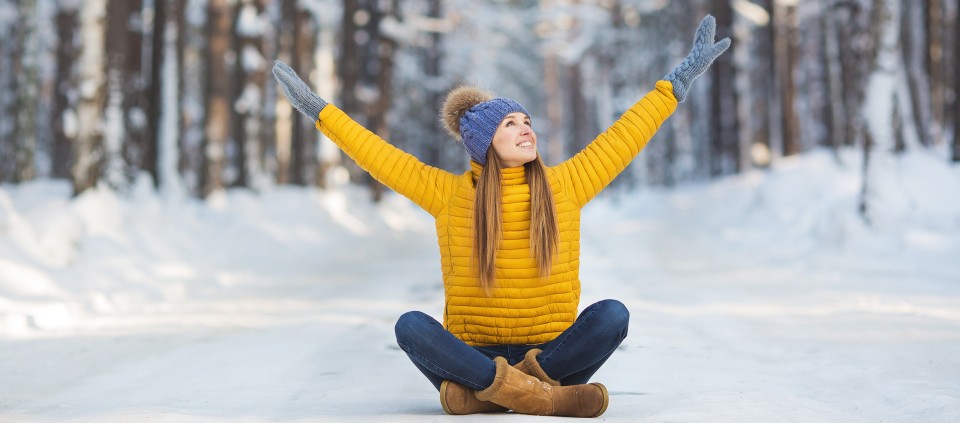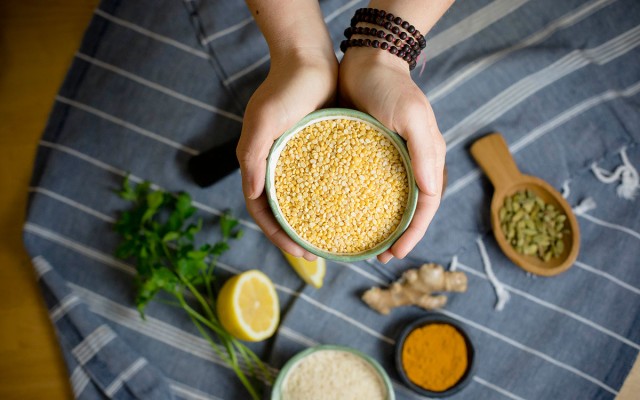A Warming Yoga Flow for Winter

According to Ayurveda, winter is the vata time of year. We experience the dryness that arrives after summer’s humidity; the coldness that settles in as the sun hangs low on the horizon in the northern hemisphere; and lightness in the form of fluffy snow. Cold, dry, and light are the qualities of space and wind, which make up vata. I like to balance out these qualities by incorporating earth, water, and a touch of fire into my yoga practice this time of year.
Because of the shorter days and longer nights, this is a restorative period. This is the time to indulge in a slow, rhythmic, fluid practice—like the one offered below—that evokes the water element, with lots of grounding poses that connect to the earth element, as both water and earth are missing in the winter. I also pepper a bit of heat into my practice to keep my internal fire toasty.
To Begin
Sit cross-legged with your low back long, sitz bones connected to the earth or propped up on a cushion for support. Your palms can rest facedown on your knees or lap; for more grounding, place a folded blanket over your lap. Lengthen your breath, allowing the breath to begin at the navel and expand toward the collarbones. Generate an intention for your practice.
Seated Warm-Up
Begin with a series of Sun Breaths. On an inhale, raise your arms overhead. As you exhale, lower your arms to your sides, fingertips brushing the earth. Repeat three to five times.
Bring your right palm to the outside of your left knee. Reach your left arm overhead and to the right, lengthening your left side into a lateral stretch. Hold for one to three breaths. Release, then repeat on the other side.
Connect both hands to your knees and inhale into Seated Cow, gently arching the spine. Exhale into a Seated Cat, rounding the back. Repeat three to five times, warming up the spine.
Bring your right hand to your left knee. Rest your left hand on the floor or on a block by your left hip. Revolve from your navel to the left, coming into a spinal twist. Release, then repeat on the other side. Flow in and out of Seated Spinal Twist three to five times.
Uncross your legs and place your feet on the outside edges of your mat. Place your fingertips behind you. Windshield-wiper your knees side to side, warming up the legs and hips and encouraging synovial fluid to move through the hips and low back.
Grounding Table Flow
Roll forward onto your hands and knees, connecting to the earth in Table pose. Place a folded blanket under your knees for support if your knees are sensitive. On an inhale, extend your right leg long behind you, feet flexed, toes hovering off the ground. On the exhale, draw the knee toward the nose, rounding the spine. After five rounds, release and repeat on the other side.
Sink back into extended Child’s pose, palms on the ground, elbows lifted. On an inhale, rise into Table, and on the exhale, shift your hips forward toward the wrists, lifting into Cobra. Keep the knees down on the earth. Inhale back through Table and exhale into extended Child’s pose.
Repeat this flow three to five times. When complete, rest in Child’s pose, knees together, arms resting down by your sides, shoulders softening over your knees. Stay for here for five to 10 breaths.
Warming Back-Body Flow
In the colder months, vata can get lodged in the back body creating a stiff back and tight hamstrings. This sequence is designed to ease to your back body back into fluid suppleness.
From Child’s pose, lift to Table. Step your left foot forward into Knee-Down Lunge; you can place a folded blanket under the right knee if you wish. Straighten the left leg, flex the left foot, and fold over the left thigh, coming into Half Splits. If your hamstrings are feeling especially tight, place your hands on blocks for support. Exhale and re-bend the left knee; on an inhale, lift your torso and come into a gentle backbend. Repeat this flow five times, then switch legs. Return to Table when you’re finished with both sides.
From Table, press up and back into Downward-Facing Dog. Pedal out your legs to warm up the hamstrings. Inhale forward into Plank pose, stacking the shoulders over the wrists, and hold for one to three breaths. On the final inhale, lift up to Down Dog. Flow from Plank to Down Dog three to five times. When you’re finished, come to rest Child’s pose, for three deep breaths.
From Child’s pose, make your way back to Down Dog. Inhale into Plank and exhale into Upward-Facing Dog. Then inhale back through Plank and exhale into Downward-Facing Dog. Repeat three times. (In this version of the vinyasa, Chaturanga is omitted, as it exhausts vata.) When you’re finished, rest in Child’s pose for five to 10 breaths.
Warm-Down
From Child’s pose, extend forward and come to rest on your belly. Place your elbows six to 12 inches in front of your shoulders for a “lazy” Cobra variation. Maintaining your arms at a 45-degree angle, rest your abdomen and lower ribs on the earth. Keep your chin parallel to the ground. Breathe fully into your abdomen, softening the lower pelvis into the earth on the exhale. Hold for five to 10 breaths. When complete, rest your forehead on stacked palms. Then flip onto your back, draw your knees into your chest, and gently rock from side to side, massaging the low spine.
Savasana
Savasana, your final resting pose, should be warm and cozy. Envelop your body in a soft, heavy blanket. Cover your eyes with an eye pillow or a scarf. Place a cushion over your lower abdomen for more grounding. Bring the palms down to rest on the earth or place one hand on your heart and one hand on your belly. Stay here for 10 or more minutes, savoring the soothing warmth generated from this practice.
Find out about Kripalu’s 300-hour Ayurvedic Yoga Teacher Training.
© Kripalu Center for Yoga & Health. All rights reserved. To request permission to reprint, please e-mail editor@kripalu.org.
Erin Casperson, Lead Kripalu Faculty and Director of the Kripalu School of Ayurveda, is passionate about sharing how the ancient practices of Ayurveda can be applied to modern-day living.
Full Bio and Programs